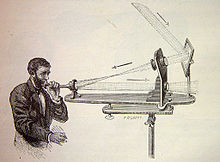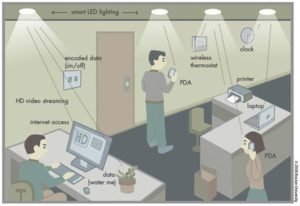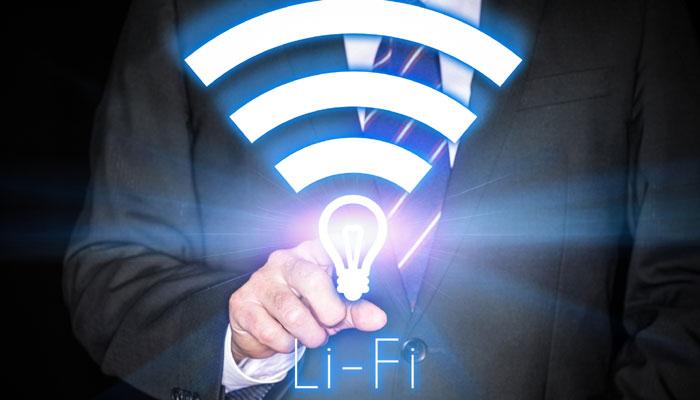Using Light to Power Your Network
Nicola Tesla, during a 1926 interview, predicted the smartphone.
Tesla said, “When wireless is perfectly applied the whole earth will be converted into a huge brain…we shall be able to communicate with one another instantly, irrespective of distance. Not only this, but through television and telephony we shall see and hear one another as perfectly as though we were face to face, despite intervening distances of thousands of miles…a man will be able to carry [a phone] in his breast pocket.”
Indeed, wireless technology has transformed human civilization. Businesses can meet anywhere, face to face, on any device; companies can stream demonstration, events, product launches, and more on a variety of websites (YouTube, Vimeo, Facebook Live, Periscope). The Internet of Things promises to connect everyone and everything from everywhere. Tesla envisioned a future in which air travel would dissolve borders, and now wireless technology has dissolved borders and has connected everyone from Des Moines to Dubai to Dublin to Dubrovnik.
Years earlier, another inventor used light to transmit sound for the first time in an invention, an invention that anticipated the next great wireless invention.
LIGHT FIDELITY

Credit: Wikipedia
Alexander Graham Bell invented the photophone on June 3, 1880. This invention used light to transmit sound. Bell considered it one of his most important revisions. The technology he used has helped computers send information around the world today. The photophone also anticipated the next stage of wireless technology:
Li-Fi
Whereas Graham Bell used a beam of light to transmit sound, Li-fi uses the visible light portion of the electromagnetic spectrum to transmit information at faster speeds (100 gigabits per second). It’s capable of transmitting information at amazing speeds, handling 1,000 times more data density. The technology could really show itself as a disruptive force by its ability to leverage the remote transmitting device’s light pulse to turn communication into solar power for the receiving device.
Li-Fi is an exciting and groundbreaking technology. Why is that? Simply put, light is the fastest ‘thing’ in the universe. Light isn’t susceptible to the same RF interference that plagues radio transmission. Li-Fi will be contained in rooms. It will not interfere with electronic circuitry in certain vital industries or with other transmitters on or off your network. Because the signal will be confined to rooms and unable to travel through walls or interfere with crucial electronic circuitry, it will provide greater safety and security.
Additionally, the FCC can’t control or regulate light. Li-Fi will offer 10,000 times more unlicensed, unregulated, and free-to-use bandwidth than what’s available on the RF spectrum. As more devices connect to wireless networks (an estimated 6 billion by 2020), more bandwidth will be a must.
Finally, because the Rx device can use the Tx device’s light as a power source, it is theoretically possible that these devices could transmit and receive into perpetuity with little or no external power.
LIFI Testing
There’s no doubt that Li-Fi is a disruptive, innovative, and groundbreaking technology, but you may wonder how the technology performed when tested by researchers.

Credit: Boston University
South Korean researchers from the Pukyoung National University wanted to know whether physicians could perform EEG and EKG tests without hooking multiple wires onto a patient. The researchers tested using light instead of wires in these two tests. The test worked. They used Li-Fi to transmit EEG brain signals, and RGB LEDs were used to amplify EEG signals. Researchers had to use color filters and photodiodes that matched each of the three LED colors and then compared the signals from each of the three photodiodes to help them select the bits that were most likely to be correct. Accuracy is paramount in biomedical science. Yeon Ho Chung, one of the engineers, told spectrum.ieee.org that he sees ‘great potential in the vast opportunities in visible light communications.”
At Oxford University, researchers used infrared light to deliver high speed data. They achieved speeds of 224 Gbps using light over two years ago.
Meanwhile, at the University of Virginia, Maite Bandt-Pearce, a professor in the Charles L. Brown Department of Electricial and Computer Engineering, along with Mohammed Noshad, a postdoctoral fellow in the Electrical Engineering Department at Harvard, used LEDs to move data faster by developing a modulation algorithm that allowed them to transmit more data at faster speeds while using no more energy than is required for running lights.
China achieved a late 2015 breakthrough when their Li-fi test clocked speeds of 50 Gbps. Rumors continue to circulate about Li-Fi support for a future iPhone model.
Last year, the world’s first Li-fi office opened in Paris, France.
As you see, the technology, has progressed significantly since Professor Harold Haas presented on it at TED Global in 2011.
The Future of Light Fidelity
Eventually, Li-Fi could become as ubiquitous as Wi-Fi and could “drive new economies” according to Haas.
- Smart street lamps could power devices.
- Power plants and aviation could utilize the technology without the present Wi-Fi based safety concerns of radio electromagnetic interference.
- Sensors could communicate to drivers about traffic and other vehicle and transportation information in real-time or change the timing of street lights to reduce congestion at rush hour. The switch to LED bulbs in tail-lights, headlights, street lights, and road signs would improve the speed of data delivery.
John Chambers, Cisco Executive Chairman and former CEO, once remarked, “Either disrupt or get disrupted.” Harold Haas has acknowledged in an interview that Li-Fi is a disruptive technology, but it won’t replace wireless fidelity. Instead, it’ll act as complementary technology to existing wireless networks. Businesses and cities will be among the first adopters. The push for Li-fi is underway in Europe.
Alexander Graham Bell loved the photophone so much he wanted to name his daughter after it. Over 100 years later, what he dreamed and invented and tested, albeit in a small, small way, may transform the globe, the transmission of data, and energy efficiency.
We’ll have to wait and see. At Aspire, we can’t wait to see what’s next.


